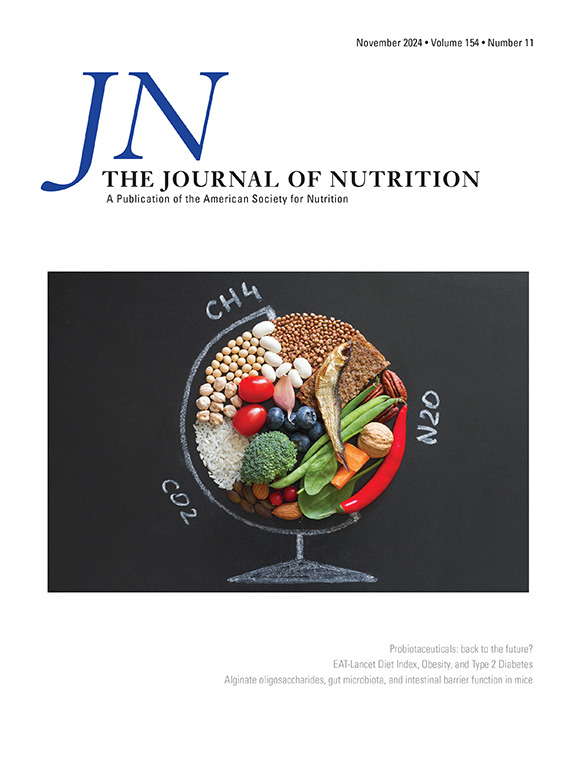Bile Acids Modulate Hepatic Glycolipid Metabolism via the Microbiota–Gut–Liver Axis in Lambs
IF 3.7
3区 医学
Q2 NUTRITION & DIETETICS
引用次数: 0
Abstract
Background
Bile acids are essential molecules that facilitate lipid emulsification and function as signaling molecules mediating host–microbiota interactions. They shape the gut microbial structure and function, playing a critical role in metabolic regulation via the gut–liver axis.
Objectives
This study aimed to investigate the effects of exogenous bile acids, primarily hyocholic acid (HCA), on the microbiota–gut–liver metabolism in male Tan-lambs fed a high-grain diet.
Methods
Thirty six–mo-old male Tan lambs (Ovis aries) were randomly allocated into either a control group or an HCA-supplemented group (n = 15 per group). The trial lasted 84 d, including a 14-d adaptation period. On day 70, 6 lambs from each group were randomly selected for slaughtering. Rumen and ileal contents were collected for microbial profiling via 16S rRNA sequencing, and liver tissue samples were harvested for transcriptomic and metabolomic analyses.
Results
The HCA intervention significant altered the composition and structure of ruminal and ileal bacteria. Notable increases were observed in Turicibacter species [linear discriminant analysis (LDA) score = 2.48; P < 0.05] and Muribaculaceae (LDA score = 3.75; P < 0.05) in the rumen, and Eubacterium fissicatena group (LDA score = 2.50; P < 0.05) in the ileum. Key hepatic genes and metabolites targeted by HCA were identified, including ENPP3, RFK, Ifi203, LIPG, CYP1A1, and CYP4A11, nordeoxycholic acid (log-fold change = 6.30; P < 0.005), α-muricholic acid (log-fold change = 5.60; P < 0.001), and β-muricholic acid (log-fold change = 5.60; P < 0.001).
Conclusions
Exogenous bile acids regulate the microbiota–gut–liver axis, influencing hepatic glycolipid metabolism in sheep. Specifically, nordeoxycholic acid demonstrates potential as a dietary intervention to promote metabolic homeostasis in ruminants. These findings highlight the potential of HCA and nordeoxycholic acid as functional feed additives or prebiotic agents for improving metabolic health in ruminants and potentially other species.
胆汁酸通过微生物-肠-肝轴调节羔羊肝脏糖脂代谢。
背景:胆汁酸是促进脂质乳化和作为信号分子介导宿主-微生物相互作用的必需分子。它们塑造肠道微生物的结构和功能,通过肠-肝轴在代谢调节中发挥关键作用。目的:研究外源性胆汁酸,主要是胆酸(HCA)对饲喂高粒饲粮的雄性滩羊肠道-肝脏微生物代谢的影响。方法:选取36只6月龄雄性滩羊,随机分为对照组(CON)和添加hca组(每组15只)。试验期84 d,其中预试期14 d。第70天,每组随机选择6只羔羊屠宰。收集瘤胃和回肠内容物,通过16S rRNA测序进行微生物分析,收集肝脏组织样本进行转录组学和代谢组学分析。结果:HCA干预显著改变了瘤胃和回肠细菌的组成和结构。Turicibacter呈显著性升高(线性判别分析(LDA)评分= 2.48;P < 0.05)和木门科(LDA评分= 3.75;P < 0.05),裂裂真杆菌组(LDA评分= 2.50;P < 0.05)。确定了HCA靶向的关键肝脏基因和代谢物,包括ENPP3、RFK、Ifi203、LIPG、CYP1A1、CYP4A11、去脱氧胆酸(对数倍变化= 6.30,P < 0.005)、α-胆酸(对数倍变化= 5.60,P < 0.001)、β-胆酸(对数倍变化= 5.60,P < 0.001)。结论:外源性胆汁酸调节微生物-肠-肝轴,影响绵羊肝脏糖脂代谢。具体来说,去脱氧胆酸显示了在反刍动物中作为饮食干预促进代谢稳态的潜力。这些发现突出了HCA和norDCA作为功能性饲料添加剂或益生元制剂的潜力,可以改善反刍动物和其他物种的代谢健康。
本文章由计算机程序翻译,如有差异,请以英文原文为准。
求助全文
约1分钟内获得全文
求助全文
来源期刊

Journal of Nutrition
医学-营养学
CiteScore
7.60
自引率
4.80%
发文量
260
审稿时长
39 days
期刊介绍:
The Journal of Nutrition (JN/J Nutr) publishes peer-reviewed original research papers covering all aspects of experimental nutrition in humans and other animal species; special articles such as reviews and biographies of prominent nutrition scientists; and issues, opinions, and commentaries on controversial issues in nutrition. Supplements are frequently published to provide extended discussion of topics of special interest.
 求助内容:
求助内容: 应助结果提醒方式:
应助结果提醒方式:


